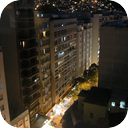(short preview of full seamless looping track)
Copacabana
This product is not available in the selected currency.
In Stock
Backordered
Out of Stock
Description
Another day on the boulevard with crowds and cars cramming into the urban passageways, keeping the city simmering with a pulse that combines the whole town's experience into a flowing mass of voices and energy throughout the day. You stand on the street corner awaiting your taxi, almost unable to imagine that in a moment you will be speeding your way through this milieu. Copacabana is the main Bolivian town on the shore of Lake Titicaca, from where boats leave for Isla del Sol, the sacred Inca island. Built between Mount Calvario and Mount Niño Calvario, the town has approximately 6,000 inhabitants. There is the belief that the name is derived from the Aymara kota kahuana, meaning "view of the lake." Nevertheless, the social scientist Mario Montaño Aragón, found in the "archives of Indias" in Sevilla, Spain, a completely different history: "Kotakawana" is the god of the fertility in the ancient Andean mythology, the equivalent to the classical Greek goddess Aphrodite or the Roman Venus. This god is androgyne and lives in the Titicaca, and his court consists of criters (male and female) that are represented in the colonial sculptures as in the Catholic churches they were called "Umantuus", known as mermaids in Western culture. Before 1534 Copacabana was an outpost of Inca occupation among dozens of other sites in Bolivia. The Incas held it as the key to the very ancient shrine and oracle on the Island of Titicaca, which they had adopted as a place of worship, yielding to the veneration in which it stood among the Aymaras from time almost immemorial. There were at Copacabana minor shrines, in which the ceremonial of the Incas was observed with that of the original inhabitants.
Opps
Sorry, it looks like some products are not available in selected quantity.



